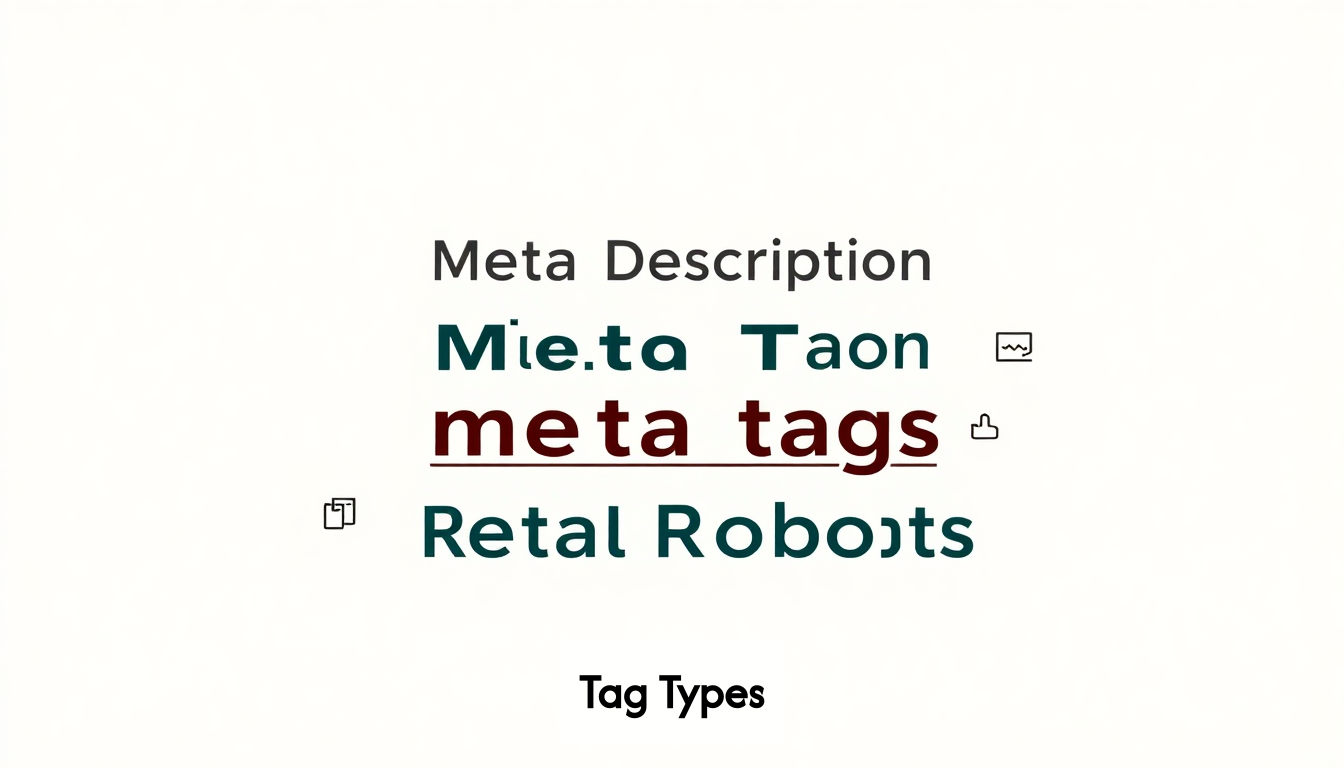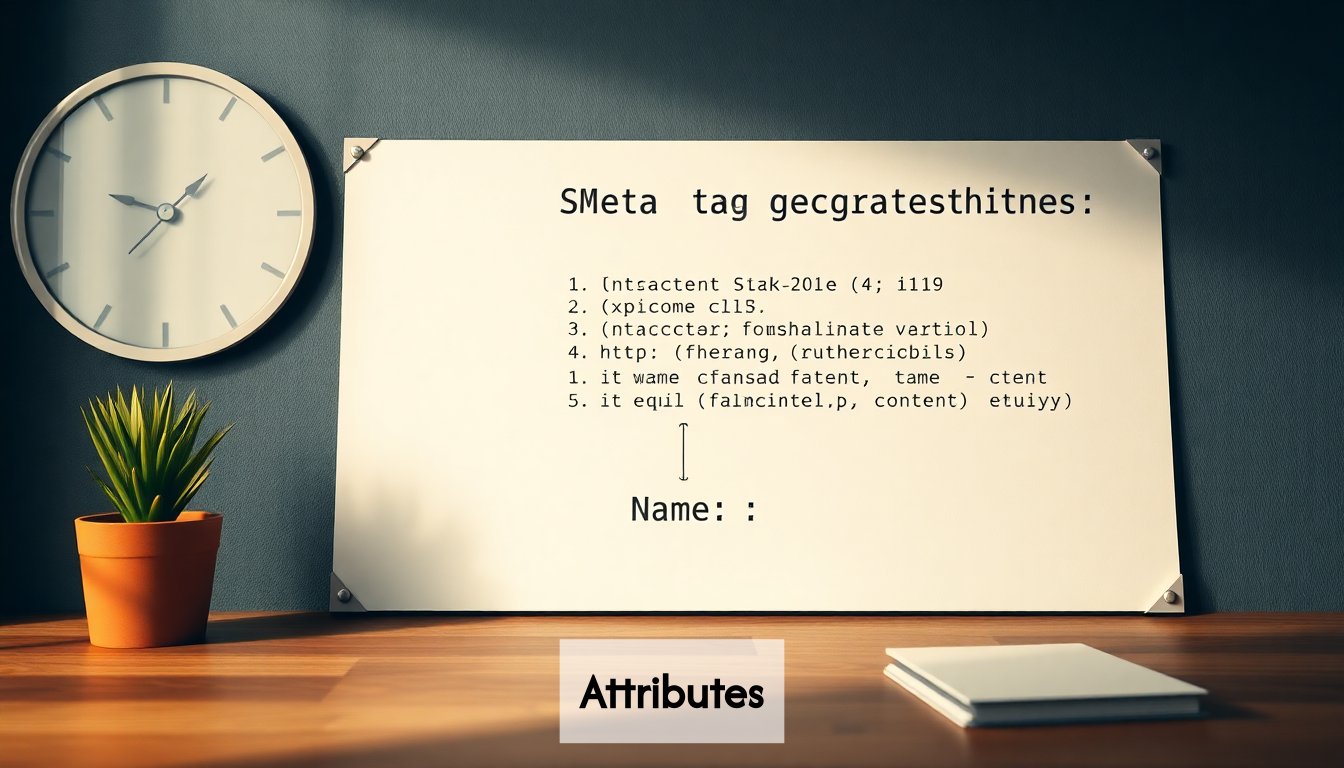The Ultimate Guide to Meta Tags: Enhancing Your Website's SEO

.jpg)
What are Meta Tags? A Comprehensive Definition
Have you ever wondered what those mysterious bits of code are that hide in your website’s HTML but never actually appear on the page itself? Well, my friend, those are meta tags – and they’re more important than you might think!

Meta tags are snippets of HTML code that provide information about a webpage to search engines and website visitors. Unlike regular HTML elements, meta tags don’t affect what users see on your page. Instead, they work behind the scenes, whispering sweet SEO nothings to Google and other search engines.
As an SEO enthusiast (okay, I admit it, I’m a bit of a nerd about this stuff), I can tell you that meta tags HTML elements are typically placed in the <head> section of your HTML document. They define various page attributes like description, keywords, author, and viewport settings.
Let me break it down with an example meta tag:
<meta name="description" content="Your compelling description goes here">
In this structure, “meta” indicates it’s a meta tag, “name” is an HTML meta attribute specifying the type, and “content” contains the actual information.
“Meta tags are the first impression your website makes on search engines,” says Sarah Johnson, SEO Director at DigitalRank. “They’re like a digital handshake that introduces your content before it’s even seen.”

Understanding what meta tags in HTML do and how to implement them correctly is crucial for your website’s visibility and performance. In the following sections, I’ll dive deeper into the different types of meta name tags and show you how to use them effectively.
Key Takeaways
| Key Point | Details |
| Meta Tags | Snippets of HTML code that provide information to search engines and visitors, placed in the <head> section. |
| SEO Impact | Proper implementation of meta tags is crucial for improving website visibility and search engine performance. |
| Types of Meta Tags | Key types include Title Tag, Meta Description, Meta Robots, Viewport Meta Tag, Open Graph, and Canonical Tag. |
| Coding Best Practices | Keep descriptions concise, use unique tags for each page, and validate tags after implementation for optimal results. |
Types of Meta Tags and Their Functions
Now that we understand what meta tags are in general, let’s dive into the wonderful world of meta tag varieties! Trust me, it’s more exciting than it sounds (at least to SEO nerds like me).
I’ve implemented countless meta tags HTML elements across various websites, and I’ve seen firsthand how they can transform your site’s performance. Here are the most important types you should know about:
Title Tag
Technically not a meta tag but often grouped with them, this defines your page’s title and appears in browser tabs and search results. It’s like your page’s name tag at the digital party!
Meta Description
This meta tag content provides a brief summary of your page. It’s the elevator pitch that appears in search results, and I’ve found that a compelling description can dramatically improve click-through rates.
Meta Robots
Think of this as instructions for search engine bots. Using this metatag, you can tell crawlers whether to index your page, follow links, or neither.

Viewport Meta Tag
With mobile browsing dominating, this tag meta tag controls how your page appears on different devices. It’s essential for responsive design!
Open Graph and Twitter Cards
These special meta name tags control how your content appears when shared on social media. I love customizing these to make shared links look professional and enticing.
Canonical Tag
This meta html tag tells search engines which version of a page is the “official” one when you have similar content on multiple URLs.
“The right combination of meta tags can be the difference between obscurity and visibility in search results,” explains Tom Martinez, Technical SEO at SearchIQ. “Each tag meta serves a specific purpose in your overall SEO strategy.”
As we explore each type in more detail throughout this guide, you’ll learn exactly how to define meta tags for maximum SEO impact.
How to Implement Meta Tags in HTML: Examples and Best Practices
Alright, let’s roll up our sleeves and get our hands dirty with some actual code! Implementing meta tags isn’t rocket science, but there are definitely some tricks to doing it right.
First things first: all meta tags belong in the <head> section of your HTML document. This is the control center where you define your meta tags HTML elements before any visible content appears.
Here’s a basic template I use when setting up meta tags en HTML for a new page:
<!DOCTYPE html>
<html>
<head>
<title>Your Amazing Page Title</title>
<meta charset="UTF-8">
<meta name="description" content="A compelling description of your page content">
<meta name="keywords" content="relevant, keywords, for, your, page">
<meta name="viewport" content="width=device-width, initial-scale=1.0">
<meta name="robots" content="index, follow">
<meta name="author" content="Your Name">
</head>
<body>
<!-- Your visible content goes here -->
</body>
</html>
When implementing these tags, I always follow these best practices:
-
Keep your meta tag content concise but descriptive
-
Use unique descriptions for each page on your meta tag site
-
Include relevant keywords naturally (don’t just stuff them in)
-
Make sure your HTML meta info accurately represents the page content
“The most common mistake I see is treating meta tags as a set-and-forget element,” says Elena Rodriguez, Frontend Developer at WebCraft Studios. “But what is meta code if not a living part of your site that should evolve with your content?”
One thing I’ve learned the hard way: always validate your HTML meta attributes after implementation. Nothing’s more embarrassing than discovering broken tags months later that have been hurting your SEO all along!
In the next section, we’ll explore how to optimize these tags specifically for search engines, because knowing what is meta name tags and how to implement them is just the first step in your SEO journey.
Common Meta Tag Attributes and Their Significance
Let’s zoom in a bit closer on the nitty-gritty details of meta tags – specifically, the attributes that make them work. Think of attributes as the special modifiers that give each meta-tag its unique powers!
When I’m building or optimizing websites, I pay close attention to these key HTML meta attributes because they determine how my meta tags function:
The “name” Attribute
The name attribute is probably the most common one you’ll encounter. It defines what type of information you’re providing. I like to think of it as the category label for your metadata.
For example, in <meta name="description" content="...")>, the name “description” tells search engines “Hey, this is what my page is about!”
Common values for the meta name tags include:
-
description
-
keywords (less important now, but still used)
-
viewport
-
robots
-
author
The “content” Attribute
This is where the actual information lives! The content attribute pairs with the name attribute to provide the specific data. It’s like filling in the blank after you’ve chosen the category.
For instance, in <meta name="robots" content="noindex, follow">, the content value is telling search engines not to index the page but to follow its links.
The “http-equiv” Attribute
This is a somewhat technical attribute that provides an HTTP header for the information in the content attribute. It’s like sending special instructions to the browser about how to handle the page.
“Understanding the relationship between meta tag attributes is essential,” explains Marcus Chen, Senior Web Developer at TechFusion. “It’s not just about including tags – it’s about structuring them correctly so browsers and search engines can interpret your intentions.”
The most common http-equiv values I work with are:
-
refresh (for timed redirects)
-
content-type (specifies character encoding)
-
X-UA-Compatible (for IE browser compatibility)
When I’m teaching newcomers about meta tags HTML, I always emphasize that these attributes work together to create meaningful instructions for browsers and search engines. It’s this synergy that makes tag meta tags so powerful for SEO optimization!
Frequently Asked Questions
What are meta tags and why are they important for SEO?
Meta tags are snippets of HTML code that provide information about a webpage to search engines and visitors. They play a crucial role in enhancing SEO by helping search engines understand the content of a page and improving visibility in search results.
How do I implement meta tags in HTML?
To implement meta tags, include them in the <head> section of your HTML document. For example:
<meta name="description" content="Your compelling description goes here">
This structure helps define the attributes of your webpage, such as title, description, and viewport settings.
What are the key types of meta tags I should use?
Key types of meta tags include Title Tag, Meta Description, Meta Robots, Viewport Meta Tag, Open Graph, and Canonical Tag. Each serves a specific function in enhancing SEO and improving click-through rates from search results.
How can I optimize my meta tags for better search engine performance?
To optimize your meta tags, keep descriptions concise, use unique tags for each page, incorporate relevant keywords naturally, and ensure accuracy in representing your page content. Regularly validate your tags to avoid potential SEO issues.
Elevate Your SEO Game with Baby Love Growth AI!
Feeling overwhelmed by the complexities of meta tags and SEO optimization? You’re not alone! Many digital marketers struggle to harness the full potential of tools like title tags, meta descriptions, and viewport settings – the very elements that could propel your website to the top of search results. With the right strategy and tools, the dense fog of SEO can clear up, revealing a pathway toward higher visibility, better click-through rates, and ultimately, increased traffic.

At Baby Love Growth AI, we’re here to transform your SEO journey. Imagine having access to AI-driven keyword discovery, keyword clustering, and content generation tools that not only simplify these technical processes but also enhance your website’s search engine performance. Our user-friendly platform is designed especially for marketers and businesses like yours, enabling you to confidently implement the essential elements you learned about in our guide to meta tags. Don’t let your competition outshine you! Start optimizing your online presence today and watch as your business ascends in the rankings.
👉 Visit https://babylovegrowth.ai now and unlock the power of AI for your SEO strategy!
Recommended Articles
BabyLoveGrowth | The #1 Ranked AI Writer for SEO BabyLoveGrowth | The #1 Ranked AI Writer for SEO BabyLoveGrowth | The #1 Ranked AI Writer for SEO BabyLoveGrowth | The #1 Ranked AI Writer for SEO BabyLoveGrowth | The #1 Ranked AI Writer for SEOSmart SEO,
Faster Growth!
Most Read Articles

Generative Engine Optimization (GEO)
Learn how Generative Engine Optimization (GEO) helps your content rank in AI search engines like ChatGPT and Google AI. This comprehensive guide explains the differences between SEO and GEO, why it matters for your business, and practical steps to implement GEO strategies for better visibility in AI-generated responses.

Track LLM Traffic in Google Analytics 4 (GA4)
Learn how to track and analyze traffic from AI sources like ChatGPT, Claude, Perplexity, and Google Gemini in Google Analytics 4. This step-by-step guide shows you how to set up custom filters to monitor AI-driven traffic and make data-driven decisions for your content strategy.

How to Humanize AI Text with Instructions
Learn practical techniques to make AI-generated content sound more natural and human. This guide covers active voice, direct addressing, concise writing, and other proven strategies to transform robotic text into engaging content.

Open AI Revenue and Statistics (2024)
Comprehensive analysis of OpenAI financial performance, user engagement, and market position in 2023. Discover key statistics including $20B valuation, $1B projected revenue, and 100M+ monthly active users.